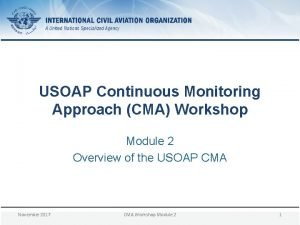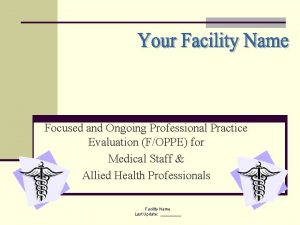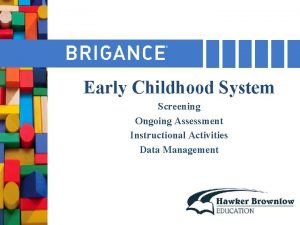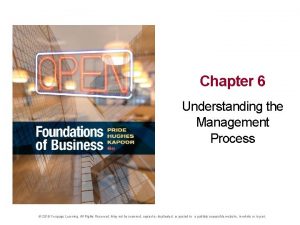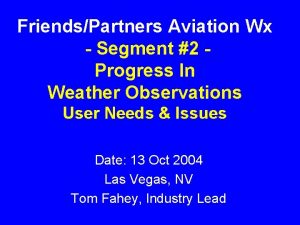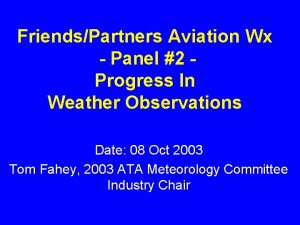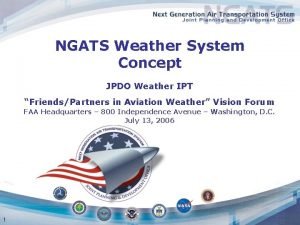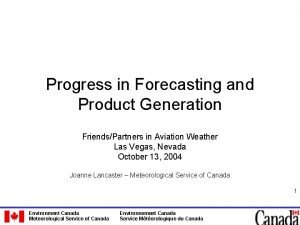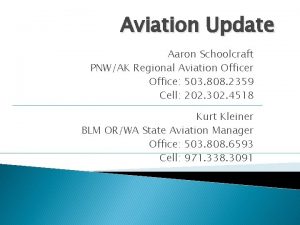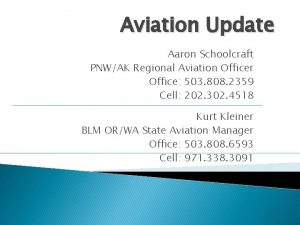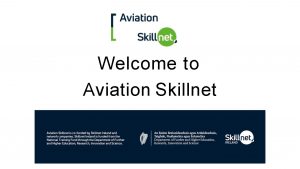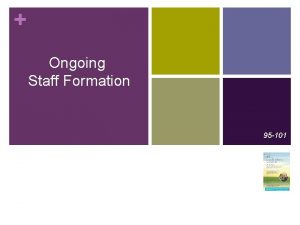Update re Ongoing Presentation to FriendsPartners in Aviation














- Slides: 14

Update re Ongoing Presentation to: Friends/Partners in Aviation Weather Name: Christopher A. Hart Date: August 8, 2012 Weather Issues In Aviation

Challenging Issues - PILOT - Failed to use available information - SYSTEM - Failed to provide available information to pilots - Failed to generate crucial information for pilots August 8, 2012 Friends/Partners in Aviation Weather 2

Owatonna, MN, July 31, 2008 • Pilots circumnavigated severe thunderstorms after storms had just passed over OWA • Most recent OWA airport weather info: 20 minutes old • Runway was – Marginal length (5500’, elev. 1146’) – Wet – Downhill • Landed with 8 knot tailwind [(130/114)2 = 1. 30] • Lift dump not engaged until 7 seconds after touchdown • Attempted go-around August 8, 2012 Friends/Partners in Aviation Weather 3

Circumventing Severe Thunderstorms August 8, 2012 Friends/Partners in Aviation Weather 44

Unsuccessful Go-Around Attempt August 8, 2012 Friends/Partners in Aviation Weather 5

Information Not Provided to Pilots • Argyle, FL, 2006 • Newellton, LA, 2006 • Ludville, GA, 2006 • Naples, FL, 2005 Examples taken from NTSB Safety Alert SA-11, Issued October 2006 August 8, 2012 Friends/Partners in Aviation Weather 6

Argyle, FL, 2006 A Mitsubishi MU-2 en route to Panama City, Florida, entered radar-depicted intense to extreme cell. No ATC radar weather information issued or requested. One fatality. August 8, 2012 Friends/Partners in Aviation Weather 7

Newellton, LA, 2006 A Mooney M 20 J encountered an intense to extreme thunderstorm and broke up in flight. No ATC radar weather information provided or requested. Two fatalities. August 8, 2012 Friends/Partners in Aviation Weather 8

Ludville, GA, 2006 A Cessna 210 en route to Manassas, Virginia, encountered intense to extreme level convective weather. The pilot requested a deviation after entering the area, but lost control of the aircraft and crashed. No ATC weather information provided. One fatality. August 8, 2012 Friends/Partners in Aviation Weather 9

Naples, FL, 2005 A Cessna 182 entered an area of severe weather over the Gulf of Mexico. Deviations discussed with ATC, but no intensity information provided by ATC or requested by the pilot. One fatality, aircraft not recovered. August 8, 2012 Friends/Partners in Aviation Weather 10

Continental Airlines Flight 1404 DEN, December 20, 2008 • Strong crosswinds, pilots discussed • Beech 1900 departed immediately prior • Demonstrated crosswind limit for 737’s: 40 knots • Airline crosswind limit: 33 knots • ATIS winds: 11 knots; winds given to pilots by controller just before takeoff (source: anemometer at opposite end of runway, more than 2 miles away): 270 deg. @ 27 knots (nearly perpendicular to runway) • Crosswind gust encountered during takeoff roll: 45 knots August 8, 2012 Friends/Partners in Aviation Weather 11

Lateral Runway Excursion August 8, 2012 Friends/Partners in Aviation Weather 12

NTSB Recommendation Areas • Research mountain wave & downslope conditions at airports downwind from mountainous terrain, identify potential mountain-wave related hazards, and disseminate results to pilots & ATC to allow for more informed runway selection decisions • ATC should provide maximum wind gust information • Improve LLWAS process and documentation • Simulator – Gusty crosswind profiles for takeoff and landing • Aircraft type specific maximum-crosswind takeoff limitation that accounts for wind gusts August 8, 2012 Friends/Partners in Aviation Weather 13

Thank You!!! Questions? August 8, 2012 Friends/Partners in Aviation Weather 14
 Is an alternative of log based recovery
Is an alternative of log based recovery The goal boy scout hike
The goal boy scout hike Usoap cma
Usoap cma Past present future continuous tense
Past present future continuous tense The goal boy scout hike
The goal boy scout hike Construction work ongoing
Construction work ongoing Goals and expected outcomes
Goals and expected outcomes Ongoing or on-going
Ongoing or on-going Ongoing professional practice evaluation template
Ongoing professional practice evaluation template Stages in consumer decision making process
Stages in consumer decision making process What is the nursing process steps
What is the nursing process steps Brigance readiness activities
Brigance readiness activities The process of evaluating and regulating ongoing activities
The process of evaluating and regulating ongoing activities On-going assessment
On-going assessment Leopold maneuver
Leopold maneuver


